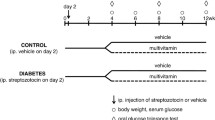Abstract
This study was designed to investigate the effects of oral zinc and magnesium supplementation on serum thyroid hormone and lipid levels in alloxan-induced diabetic rats. Thirty-two albino male rats, weighing 234±34 g, were divided into four experimental groups (control, diabetic, diabetic+zinc supplemented and diabetic+ magnesium supplemented). The experiment lasted for 60 d. The first 45 d of the experiment was the supplementation and last 15 d was the supplementation and diabetes-inducing period. Diabetic+zinc-supplemented and diabetic+magnesium-supplemented groups were given orally (by adding in their drinking water) 227 mg/L of zinc and 100 mg/kg body weight (bw) of magnesium, respectively throughout the experiment. Control and diabetic groups served as controls and did not receive zinc or magnesium supplementation. Diabetic, diabetic+zinc-supplemented, and diabetic+magnesium-supplemented groups were given a daily injection (ip) of 100 mg/kg bw of alloxan for 15 d starting on d 46 of the experiment. The control group was only injected with the same volume of isotonic NaCl as the diabetic group received. At the end of the of the experiment, rats in all four groups were fasted for 12 h and blood samples were taken from the heart under ether anesthesia for the determination of thyroid hormone, glucose, total cholesterol, and triglyceride concentrations. It was found that serum glucose, total cholesterol, and triglyceride concentrations were higher and serum T3 and T4 concentrations were lower in diabetic rats than those in the control group. Zinc supplementation did not change any parameter in diabetic rats. However, magnesium supplementation decreased the elevated total cholesterol and triglyceride concentrations of the diabetic rats to the control level. It was concluded that oral magnesium supplementation might decrease the diabetes-induced disturbances of lipid metabolism.
Similar content being viewed by others
References
D. K. Granner, Hormones of the pancreas and gastrointestinal tract, in Harper’s Biochemistry, R. K. Murray, D. K. Granner, P. A. Mayes, and V. W. Rodwell, eds., Lange Medical Publications, CT, pp. 568–569 (1993).
D. B. Sacks, Implications of the revised criteria for diagnosis and classification of diabetes mellitus, Clin. Chem. 43, 2230–2233 (1997).
F. Turkmen, I. Akkus, S. Buyukbas, and A. Cigli, Complications and biochemical changes in diabetes mellitus, T. Klin. Tip. Bil. 10, 1–10 (1990).
J. H. Oppenheimer, H. L. Schwartz, C. N. Mariash, W. B. Kinlaw, N. C. W. Wong, and H. C. Freake, Advances in our understanding of thyroid hormone action at the cellular levels, Endocr. Rev. 8, 288–308 (1987).
N. Bagchi, N. Palaniswami, H. Desai, J. Felicetta, and T. R. Brown, Decreased thyroidal response to thyrotropin in type II diabetes mellitus, Metabolism 37, 669–671 (1988).
L. A. Gavin, F. A. McMahon, and M. Moelier, The mechanism of impaired T3 production from T4 in diabetes, Diabetes 30, 694–699 (1981).
E. Sluszkiewicz, Thyroid function in insulin-dependent diabetic children, Exp. Clin. Endocrinol. 87, 345–348 (1986).
S. Fujimato, Y. Indo, A. Higashi, I. Matsuda, N. Kashiwabara, and I. Nakashima, Conversion of thyroxine into tri-iodothyronine in zinc-deficient rat liver, J. Pediatr. Gastroenterol. Nutr. 5, 799–805 (1986).
M. Yenigun, Cardiovascular Diabetes, Istanbul University Press, Istanbul (1997).
F. Corica, A. Allegra, A. Di Benedetto, M. S. Giacobbe, G. Romano, D. Cucinotta, et al. Effects of oral magnesium supplementation on plasma lipid concentrations in patients with non-insulin-dependent diabetes mellitus, Magnesium Res. 7, 43–47 (1994).
T. W. Balon, J. J. Gu, Y. Tokuyama, A. P. Jasman, and J. J. Nadler, Magnesium supplementation reduces development of diabetes in a rat model of spontaneous NIDDM, Am. J. Physiol. 269, E745-E752 (1995).
M. Kimura, M. Ujihara, and K. Yokoi, Tissue manganese levels and liver pyruvate carboxylase activity in magnesium-deficient rats, Biol. Trace. Element Res. 52, 171–179 (1996).
A. Goel, D. Dhawan, and S. Kheruka, Evaluation of zinc in the regulation of serum T3 and T4 levels and hepatic functions in carbontetrachloride-intoxicated rats, Biol. Trace. Element Res. 41, 59–68 (1994).
Y. Yamaguchi, S. Kitagawa, M. Kunitomo, and M. Fujiwara, Preventive effects of magnesium on raised serum lipid peroxide levels and aortic cholesterol deposition in mice fed an atherogenic diet, Magnesium Res. 7, 31–37 (1994).
M. Yenson, Clinical Biochemistry, 6th ed., Beta, Istanbul (1986).
A. L. Bobson, IMMULITE Automated Immunoassay System, J. Clin. Immunassay 14, 83–88 (1991).
C. Douillet, Y. Chancerelle, C. Cruz, C. Morancles, J. F. Kergonou, S. Renaud, et al. High dosage vitamin E effect on oxidative status and serum lipids distribution in streptozotocin-induced diabetic rats, Biochem Med. Metab. Biol. 50, 265–276 (1993).
S. Ekin and N. Mert, Investigation of trace elements (Cu, Zn, Fe, Cr, Mn), minerals (Mg, K), total sialic acid and lipid-bound sialic acid levels in patients with non-insulin dependent diabetes mellitus, Ph. D. thesis, Yuzuncu Yil University, Health Sciences Institute (2001).
G. M. Reaven and M. S. Greenfield, Diabetic hypertriglyceridemia. Evidence for three clinical syndromes, Diabetes 30, 66–75 (1981).
G. M. Reaven and C. E. Mondon, Effect of in vivo plasma insulin levels on the relationship between perfuse free fatty acid concentration and triglyceride secretion by perfused rat livers, Horm. Metab. Rev. 16, 230–232 (1984).
G. M. Reaven, Role of insulin resistance in human disease, Diabetes 37, 1595–1607 (1988).
E. Gueux. A. Mazur, P. Cardot, and Y. Rayssiguier, Magnesium deficiency affects plasma lipoprotein composition in rats, J. Nutr. 121, 1222–1227 (1991).
Author information
Authors and Affiliations
Rights and permissions
About this article
Cite this article
Baydas, B., Karagoz, S. & Meral, I. Effects of oral zinc and magnesium supplementation on serum thyroid hormone and lipid levels in experimentally induced diabetic rats. Biol Trace Elem Res 88, 247–253 (2002). https://doi.org/10.1385/BTER:88:3:247
Received:
Revised:
Accepted:
Issue Date:
DOI: https://doi.org/10.1385/BTER:88:3:247




